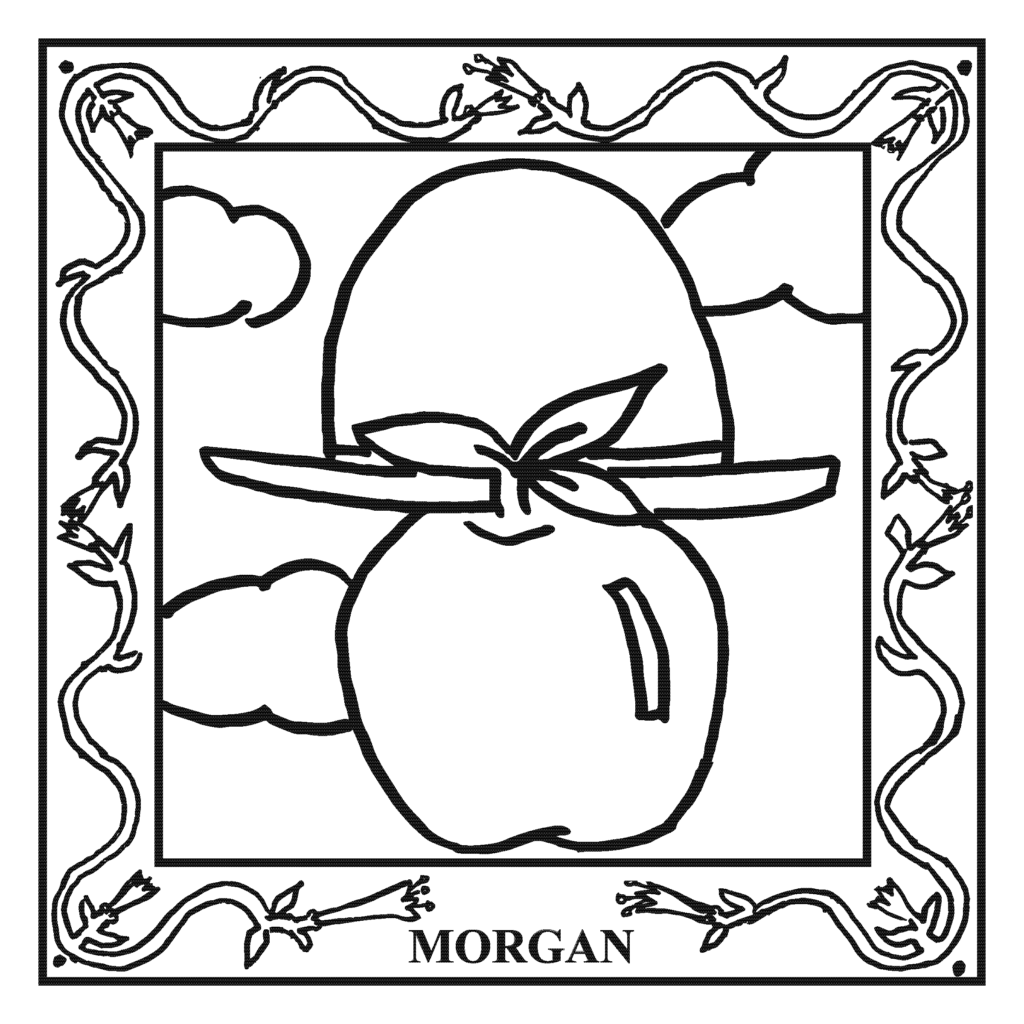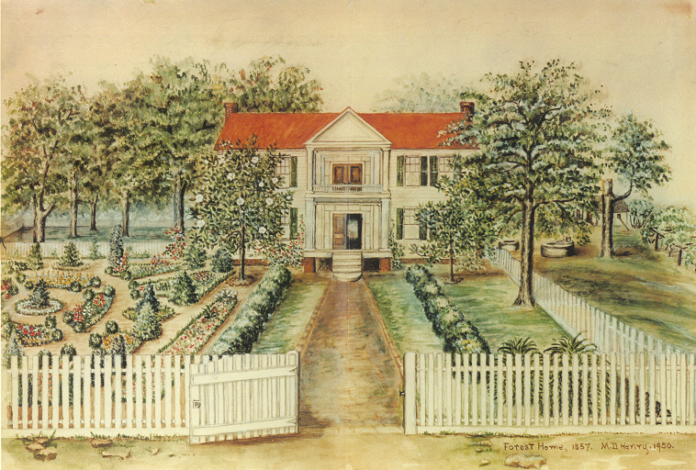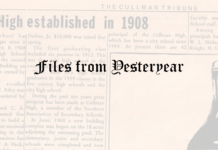The Cullman Tribune is celebrating the Alabama Bicentennial (1819-2019) with statewide field reporting by Alabama Master Gardener/Botanical Artist Ben Johnson South. This year-long feature, “The 67-County Alabama Garden Party,” will spotlight different counties each week. Each county will get its own “quilt block,” along with a historical profile, and we’ll share a recipe specific to the area. At the end of the year, all 67 counties will be put in a book to commemorate the Bicentennial.
Morgan County
A “Lost Garden of the Old South” is hidden in a copse of tall trees in Morgan County, Alabama. It was created by a woman with knowledge of the geometry of design, the agronomy of red clay soil and a botanist’s understanding of which plants could thrive in her part of the world. She also had a genteel, “steel magnolia” determination to will her exquisite vision into reality. This Morgan County gardener was Ann Fennel Davis.
Forest Home was a 500- acre, 19th century plantation, where Ann Fennel Davis and her husband, Absalom Leonidas Davis, a scholarly academic, lived and she gardened with their free and enslaved workers. The land is now an upscale, 21st century, residential development named Forest Home Estates. The surrounding community was and is Trinity, Alabama.
“The Lost Garden of Forest Home” first crossed my radar about 25 years ago. My source was a gentleman in Birmingham, George Robert Stritikus, who was a prominent member of the Southern Garden History Society. Mr. Stritikus, the Jefferson County agent for the Alabama Cooperative Extension System, had been instrumental in the restoration of several period gardens in Alabama. We were in his downtown office shooting the breeze about Southernness and gardens when, just like some character in an “Indiana Jones” movie, he walked over to a cabinet, unlocked a drawer and pulled out a watercolor “imagining” of Ann Fennel Davis’ garden, circa 1858. The illustration had been painted by M.D. Henry in 1950. Later, George Stritikus graciously gifted me with a copy of this lovely botanical art, which I shared with Morgan County archivist, John Allison, yesterday.
The main house at Forest Home, completed in 1857, had not been inhabited for many years and burned to the ground one hot, dry weekend in October 1991. There is no manmade marker for the home nor for Ann Fennel Davis’ “lost garden.” However, two impressively knowledgeable and intrepid members of the Morgan County Historical Society, David Burleson (Hartselle) and Phil Wirey (Decatur) accompanied me on an adventure this week to identify this important place in Alabama where PLANTS + PEOPLE came together.
We drove west from Decatur and took the Old Trinity Road. The main street as you turn into Forest Home Estates is, note the spelling, Forrest Home Drive. It is at the end of this drive, using old, aerial maps, that we were able to identify the gentle rise where the main plantation house would have been at the end of a long, landscaped allee’ of native cedar trees. The Davises would look from their front double-veranda out into Mrs. Davis’ beautifully designed and pristinely maintained garden and then farther south to the many acres of agricultural production spread before them. The main cash crop for Forest Home and most of Morgan County’s hard-packed, red clay farms was cotton. Corn was also a row crop, grown mostly for feeding livestock. Additionally, there was a large vegetable garden and fruit tree orchard shared by everyone on the plantation.
“The Lost Garden of Forest Home,” designed by Ann Fennel Davis, was influenced by the formal patterns of the Virginia gardens her grandmother, Burchet (Curtis) King, remembered. Ann Fennel’s mother, Mary Curtis King Fennel, also had a prized, ornamental garden in Morgan County (Decatur) at her home, Riverview. As the garden at Forest Home matured it became an attraction for visitors from near and far. Ann Fennel Davis’ composition was a large center ring with rounded beds, segmented with gravel paths and four smaller rings in the corners of a large, fenced square. The centermost planting was an evergreen yew. All the beds had boxwood parterres bracketed with taller evergreens and were planted for seasonal flowers. Amongst the myriad blossoms were lilies, peonies, dahlias and 150 varieties of roses. Large commercial nurseries supplying such plants to Alabama during this era were in Memphis, Mobile and New Orleans.
Yankee soldier diaries record how valuable plants such as boxwood shrubs and roses, many of those with historic origins in Empress Josephine’s garden at Malmaison, were dug out of Southern soil and replanted in the northern part of the nation. So far, we have found no records about what is left of Ann Fennel Davis’ “Lost Garden at Forest Home.” This could be an exciting exploration for garden historians and an ideal project to launch this year as we celebrate Alabama’s Bicentennial. Perhaps there is plant material original to this important Alabama garden that could serve future gardeners. Remember, the study of garden history begins at the triumph of the last, new sprig.
For more information on the history of Forest Home and the “lost garden” of Ann Fennel Davis, I encourage you to rely on the expert and gracious help of David Breland, director of historic resources for the City of Decatur (you’ll find him at the grand Old State Bank, Alabama’s oldest bank building, which has a charming butterfly garden in back and a sweeping, greenspace and amphitheater in front) and John Allison, Morgan County Archives (Decatur). Also, the Morgan County Historical Society, an all-volunteer group, is extremely knowledgeable and eager to support historical research.
You may not have a historic garden to restore, but many of us have overgrown and neglected gardens. Here are some suggestions shared by garden preservationists to consider for any garden:
- GO SLOW- Live through all four seasons with your garden before you make major design decisions.
- EDIT- Clear out all the unwanted volunteer plants, like privet, but use few chemicals which could kill desirable plants and bulbs.
- PRUNE- Allow for fresh growth.
- BUDGET- Understand your personal priorities and fund those.
- STAY TRUE TO THEME- It’s as important what you not add to the garden as what you do.
- ENJOY EACH STAGE- A garden is about change; stop and smell the roses, and then mulch.
Here are other ways PLANTS + PEOPLE intersect positively and pleasurably in Morgan County, including a recipe for MORGAN COUNTY APPLE CIDER SYLLABUB:
*MORGAN COUNTY FARMERS MARKETS-Decatur Farmers Market , 211 First Ave. SE; Hartselle Farmers Market, Sparkman Street SE; Church of The Good Shepherd Farmers & Artisans Market (Decatur) August-October
*MORGAN COUNTY FARMSTANDS- Burl Slaten (Hartselle), Clark Produce (Decatur), Fred Motes (Hartselle), James Vest (Eva), Reeves Farm (Hartselle)
*MORGAN COUNTY U-PICK- Fagerman Farm (Somerville); Gin House Branch Farm (Decatur) blueberries, muscadines, local honey; James Vest (Eva) strawberries, okra, peppers, watermelons, other; Reeves Farm (Hartselle) pumpkins, strawberries, tomatoes
*THE RAILYARD RESTAURANT- Perfect for locavores, this popular watering hole is in walking distance of the Morgan County Farmers Market, and the chef has worn a path between these two hot spots; our waiter provided a list of top notch Alabama craft beers, including ones from the Cross-Eyed Owl Brewing Company in downtown Decatur (the brewery is another great coming together of PLANTS + PEOPLE in Morgan County and a fun place to visit).
*SUNWISE FLOWERS (Hartselle at Westview Plantation)- Local cut flowers grown by Forrest Burleson and Eryn Elledge; sold at the Morgan County Farmers Market.
*MORGAN COUNTY HISTORIC CEMETERIES- These are also landscaped, tree-shaded works of art. In one day, I toured the Lafayette Street Cemetery (downtown Decatur dating to 1818, the year of Alabama statehood); the cemetery at Fennel Turnout (original name of Trinity) where you should note the graves of Ann Fennel Davis and her mother, Mary Fennel, were designed to be planted as flower beds, and, you will want a Morgan County Historical Society guide with machete for this next “hidden garden,” the Garth-Dancy Cemetery in the middle of the woods contiguous to Roselawn Cemetery.
*WALDEN OAKS PARK- A charming “pocket park” dedicated as a place of peace and inspiration, itself inspired by the writings of naturalist and early environmental visionary, Henry David Thoreau.
*DELANO PARK CONSERVANCY- This nonprofit group of garden enthusiasts has gloriously transformed a large public space, Delano Park, from so-so to splendiferous; the park is open FREE to the public every day of the year; 10,000 plants, 10 kid-friendly sculptures on 28 acres right in the heart of Decatur with a mile-long, heart-healthy walking path.
*WHEELER WILDLIFE REFUGE- Comprised of a great diversity of plant habitats such as bottomland hardwoods, pine uplands, wetland bogs and riparian woodlands, established in 1938 as a sanctuary for migrating birds, this national treasure also has five walking trails to enjoy the birding: Atkeson Cypress Trail, Dancy Bottoms Trail, Flint Creek Trail, Beaverdam Swamp Boardwalk, Wildlife Observation Building.
*TENNESSEE VALLEY PECAN COMPANY- “Welcome to the Nut House” its slogan teases; this has been the pride of area kitchens since 1942; 806 Bank St. NE, Decatur.
*AMERICAN INDIAN INTERPRETIVE WALKING TRAILS- 5.5 miles of marked paths at the vast Point Mallard complex to enjoy natural beauty and learn about the Native American tribes that populated this part of Alabama.
*PLANTING AN IDEA- Erect a historic marker recognizing the imagination and labor of Ann Fennel Davis and her workers at the site of “The Lost Garden of Forest Home.”
Y’ALL COME to Morgan County on your 67-COUNTY, ALABAMA GARDEN PARTY tour! An impressive array of gardens, history and garden history awaits you.
My sincere thanks to Morgan County Archivist John Allison, and to Judge David Breland, David Burleson and Phil Wirey for sharing their knowledge and enthusiasm for the area history, especially the garden history, of this part of Alabama. And, thank you to Allyson Shabel of the Morgan County Office of the Alabama Cooperative Extension System for all the connections and ideas you provided.
MORGAN COUNTY APPLE CIDER SYLLABUB
This classic, Southern, 19th century sipper would have been graciously served by Ann Fennel Davis to guests at Forest Home, highlighting apple cider pressed from the Davises’ Morgan County orchard.
INGREDIENTS
- 3 Morgan County Golden Delicious apples, peeled, cored and chopped
- 2 tbsp. water
- 1 tbsp. super fine, granulated sugar
- 2/3 cup apple cider
- Zest and juice of 1 lemon
- 3 1/2 super fine, granulated sugar
- 10 ounces heavy double cream
- Garnish of fresh mint leaves and apple slices
DIRECTIONS
- Put chopped apples, water and 1 tbsp. sugar in a saucepan and cook 8-10 minutes until soft. Allow to cool.
- Put apple cider, lemon zest and juice, 3 1/2 tbsp. super fine, granulated sugar and cream in a bowl and whisk to blend.
- Carefully fold in the apple puree and spoon into 6 glasses.
- Refrigerate to chill for 1-2 hours; garnish and serve.
Serves 6
Also, check out Alabama Bicentennial: 200 ways to save Alabama for the next 200 years.
Copyright 2019 Humble Roots, LLC. All Rights Reserved.

The Alabama honeysuckle border quilt block was inspired by an 18th century, Southern applique quilt. (A note about the Morgan County Bicentennial “quilt block” art: this combines a fun bit of art history and plant history; inspired by famed Surrealist, Rene Magritte’s 1964 self-portrait titled “Son Of Man,” but coloring-ready art using a green, Morgan County apple topped with a bowler hat.)

























